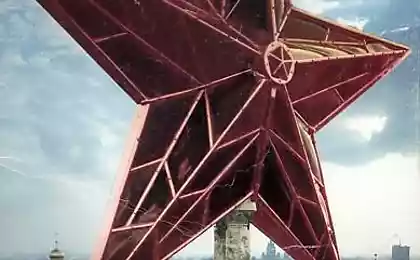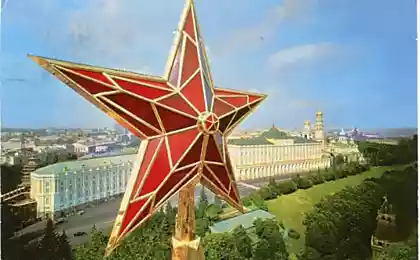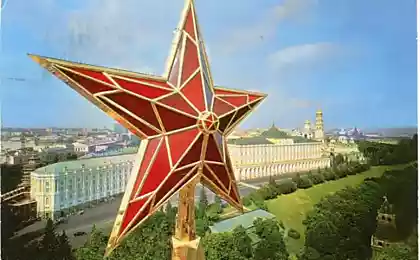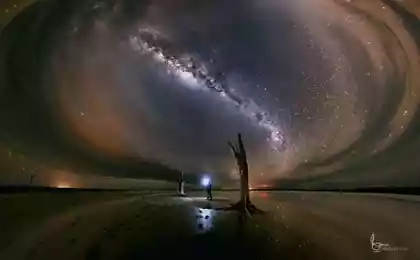1805
History of the Kremlin stars (15 photos)
Stars on the Kremlin towers were not so long ago. Until 1935 in the heart of the country of victorious socialism still adorned gilded characters tsarist double-headed eagles. Under the cut is not an easy story Kremlin stars and eagles.
Since the 1600s the four towers of the Kremlin (Trinity, the Saviour, and Nicholas Borovitskaya) decorated with symbols of Russian statehood - huge gilded two-headed eagles. These eagles are not seated at the spiers centuries - they change quite often (after all, still some researchers argue from what they were material - metal or gilded wood, there is evidence that some body eagles - if not all - was made of wood, and other details - metal, but it is logical to assume that those first two-headed birds, were made entirely of wood). This fact - the fact of constant rotation capstan jewelry - to remember, because it was he who subsequently played a major role during the replacement of the Eagles at the stars.


In the first years of Soviet power all the double-headed eagles in the country were destroyed, all but four. Four gilded eagle sitting on the towers of the Kremlin. Replacing the royal eagles red stars on the Kremlin towers repeatedly arose soon after the revolution. However, this change was associated with large cash expenditures and therefore could not be held in the first years of Soviet power.

A real opportunity to provide funding for the installation of stars on the Kremlin towers appeared much later. In 1930 he turned to the artist and art critic Igor Grabar asking you to set the artistic and historical value of the Kremlin eagles. He replied: & quot; ... none of the currently existing on the Kremlin towers eagles is not an ancient monument and as such can not be protecting & quot ;.
Parade of 1935. Eagles look like flies Maxim Gorky and spoil the celebration of Soviet power.

In August 1935, in the national press have posted the following message TASS: "The Council of People's Commissars of the USSR, the Central Committee of the CPSU (b) decided to November 7, 1935 to remove 4 eagle located on the Saviour, St. Nicholas, Borovitskaya, Trinity Tower Kremlin wall, and 2 Eagle Historical Museum. By that same date, decided to install on these four towers of the Kremlin five-pointed star with hammer and sickle ».
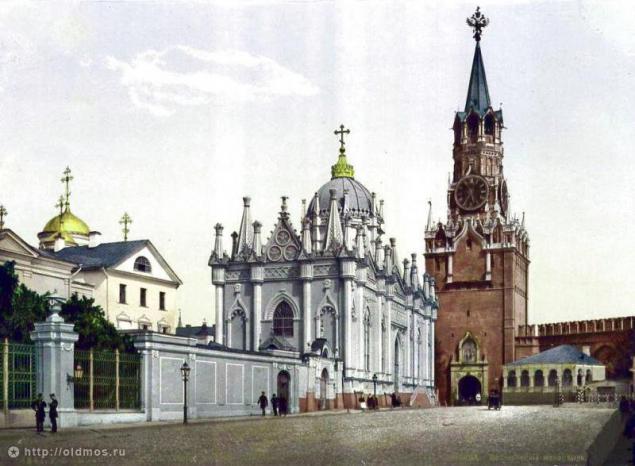
And eagles removed.


Design and production of the first stars of the Kremlin was entrusted to two Moscow factories and workshops Central hydrodynamic Institute (TsAGI). Outstanding designer, academician Fyodor Fedorov started to develop sketches of future stars. He determined their shape, size, pattern. Kremlin stars decided to be made of high-alloy stainless steel and red copper. In the middle of each star, from both sides were lined with sparkle gems hammer and sickle emblem.

When thumbnails are created, produced models of stars in full size. Hammer and sickle emblem inlaid temporarily imitations of precious stones. Each star-lit layout twelve spotlights. That's what supposed to cover the real stars on the Kremlin towers at night and on cloudy days. When incorporated spotlights, stars sparkled and glittered myriad of colored lights.
Inspect the finished model came leaders of the party and the Soviet government. They agreed to manufacture the stars with a sine qua non - to make them rotate, to Muscovites and visitors can admire them from anywhere.
The work on creation of the Kremlin stars attended by hundreds of people of various specialties. For the Saviour and Trinity Towers stars produced in the workshops of TsAGI led by Chief Engineer Institute AA Arkhangelsk, and to Nicholas and Borovitskaya - at the Moscow plant under the leadership of chief designer.
All four stars differ from each other decoration. So, on the faces of the stars of the Spasskaya tower were coming from the center of the beams. Trinity Tower on the star-rays were made in the form of spikes. Star Borovitskaya tower consisted of two circuit inscribed one into another. And the rays of the star Nicholas tower drawing had.
Star Spasskaya and Nikolskaya Towers were similar in magnitude. The distance between the ends of four beams was 5 meters. Star Trinity and Borovitskaya towers were smaller. The distance between the ends of beams are respectively 4 and 3, 5 meters.

The supporting structure of the star performs a lightweight, durable stainless steel frame. This framework imposed framing ornaments of red copper sheets. They were covered with a gold thickness of 18 to 20 microns. On each star on both sides strengthened the hammer and sickle emblem size of 2 meters and a weight of 240 kilograms. Posters were decorated with precious stones of the Urals - rock crystal, amethyst, alexandrite, topaz and aquamarine. For the manufacture of eight emblems took about 7,000 stones in size from 20 to 200 carats (one carat is equal to 0, 2 grams.) From the report paupers employee Operations Division of the NKVD: "Every stone is faceted diamond Galley (73 faces) and reduce the risk of embedded in a separate caste silver with silver screw and nut. The total weight of all stars - 5600 klgr. ».
Star for St. Nicholas Tower. 1935. ph. B.Vdovenko.

Emblem frame was made of bronze and stainless steel. This frame was attached separately each gem mounted in gilded silver. Two hundred and fifty of the best jewelers in Moscow and Leningrad and a half months of work on the creation of logos. Principles locations stones were developed by Leningrad artists.
The design of the stars was designed to load the hurricane. At the base of each star have established special bearings manufactured at the First Bearing Plant. Thanks to this star, despite the considerable weight, can easily rotate and become its front side against the wind.

Before installing the stars on the Kremlin towers engineers doubt: the tower will stand whether their severity and storm wind loads? After each star weighed on average a thousand pounds and had a sailing surface 6, 3 square meters. With careful study found that the upper part of the towers and arches tents come in a dilapidated condition. It was necessary to strengthen the masonry of the upper floors of the towers, which had set the stars. In addition, the tents Spassky, Trinity and Borovitskaya towers additionally introduced metallic bonds. A tent Nicholas tower was so dilapidated that it had to build anew.

Now the specialists of the All-Union office Stalprommehanizatsiya LN Schipakovym, IV Kuneginym, NB Gitmanom and II Rechetov got important task - to pick up and set the stars on the Kremlin towers. But how to do it? After all, the lowest of them, Borovitskaya, has a height of 52 meters, and the highest, Trinity - 77 meters. While a large crane was not, experts Stalprommehanizatsii found an original solution. They are designed and built for each tower a special crane, which can be installed on its top tier. At the base of the tent through the turret window was inserted into a metal base - console. It's the collected crane.
The day when everything was ready to rise five-pointed stars. But before they decided to show the Muscovites. October 23, 1935 star was taken to the Central Park of Culture and Rest. Gorky and installed on pedestals, upholstered in red cloth. In the spotlight shone with gold rays sparkled Ural gems. Inspect the stars came secretary of the city and district committees of the CPSU (b), the chairman of the Moscow City Council. In the park came hundreds of Muscovites. Everyone wanted to enjoy the beauty and majesty of the stars that were soon to erupt in the sky of Moscow.
Removing the Eagles put on display there.

October 24, 1935 on the Spasskaya Tower established the first star. Before lifting it carefully polished with a soft cloth. At this time, the mechanics checked the winch and motor crane. At 12 hours and 40 minutes later there was a team "Veera little!" Star off the ground and began to slowly rise. When she was at the height of 70 meters, the machine stopped. Standing on the top of the tower climbers carefully picked and sent a star on the spire. In 13 hours 30 minutes star goes right to the reference pin. Eyewitnesses remember that on that day the Red Square gathered several hundred people who watched the operation. At the time when the star appeared on the spire, the whole crowd started cheering climbers.
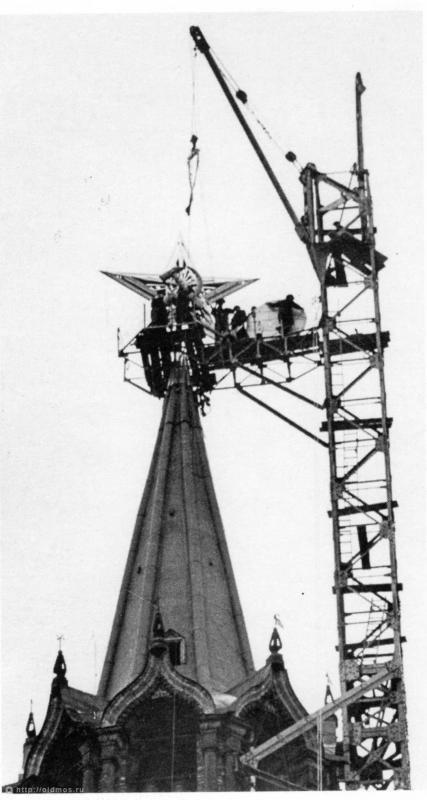
The next day, five-pointed star was installed on the spire of Trinity Tower. October 26 and 27 stars shine over St. Nicholas and Borovitskaya towers. Installers have worked so lifting technique that they needed to install each star is not more than half hours. The exception was the star of Trinity Tower, the rise is due to the strong wind lasted about two hours. From the moment the newspapers published a decree on setting stars, just over two months. Or rather - only 65 days. Newspapers wrote about the labor heroism of Soviet workers, who for a short period of time to create a true work of art.
Star with Spassky Tower spire crowned now River Station.

The first stars long adorned the tower of the Moscow Kremlin. One year later, under the influence of precipitation dimmed Ural gems. In addition, they do not fully fit into the architectural ensemble of the Kremlin because of the large size. Therefore, in May 1937, it was decided to establish new stars - glowing, ruby. Then the four towers with stars added another one - Vodovzvodnaya. Chief engineer for the design and installation of stars was appointed Professor Alexander Landa (Fishelevich). In Samara, still kept his project - five massive albums of drawings in red bindings. Say, are no less impressive than the stars themselves.
zyalt
Since the 1600s the four towers of the Kremlin (Trinity, the Saviour, and Nicholas Borovitskaya) decorated with symbols of Russian statehood - huge gilded two-headed eagles. These eagles are not seated at the spiers centuries - they change quite often (after all, still some researchers argue from what they were material - metal or gilded wood, there is evidence that some body eagles - if not all - was made of wood, and other details - metal, but it is logical to assume that those first two-headed birds, were made entirely of wood). This fact - the fact of constant rotation capstan jewelry - to remember, because it was he who subsequently played a major role during the replacement of the Eagles at the stars.


In the first years of Soviet power all the double-headed eagles in the country were destroyed, all but four. Four gilded eagle sitting on the towers of the Kremlin. Replacing the royal eagles red stars on the Kremlin towers repeatedly arose soon after the revolution. However, this change was associated with large cash expenditures and therefore could not be held in the first years of Soviet power.

A real opportunity to provide funding for the installation of stars on the Kremlin towers appeared much later. In 1930 he turned to the artist and art critic Igor Grabar asking you to set the artistic and historical value of the Kremlin eagles. He replied: & quot; ... none of the currently existing on the Kremlin towers eagles is not an ancient monument and as such can not be protecting & quot ;.
Parade of 1935. Eagles look like flies Maxim Gorky and spoil the celebration of Soviet power.

In August 1935, in the national press have posted the following message TASS: "The Council of People's Commissars of the USSR, the Central Committee of the CPSU (b) decided to November 7, 1935 to remove 4 eagle located on the Saviour, St. Nicholas, Borovitskaya, Trinity Tower Kremlin wall, and 2 Eagle Historical Museum. By that same date, decided to install on these four towers of the Kremlin five-pointed star with hammer and sickle ».

And eagles removed.


Design and production of the first stars of the Kremlin was entrusted to two Moscow factories and workshops Central hydrodynamic Institute (TsAGI). Outstanding designer, academician Fyodor Fedorov started to develop sketches of future stars. He determined their shape, size, pattern. Kremlin stars decided to be made of high-alloy stainless steel and red copper. In the middle of each star, from both sides were lined with sparkle gems hammer and sickle emblem.

When thumbnails are created, produced models of stars in full size. Hammer and sickle emblem inlaid temporarily imitations of precious stones. Each star-lit layout twelve spotlights. That's what supposed to cover the real stars on the Kremlin towers at night and on cloudy days. When incorporated spotlights, stars sparkled and glittered myriad of colored lights.
Inspect the finished model came leaders of the party and the Soviet government. They agreed to manufacture the stars with a sine qua non - to make them rotate, to Muscovites and visitors can admire them from anywhere.
The work on creation of the Kremlin stars attended by hundreds of people of various specialties. For the Saviour and Trinity Towers stars produced in the workshops of TsAGI led by Chief Engineer Institute AA Arkhangelsk, and to Nicholas and Borovitskaya - at the Moscow plant under the leadership of chief designer.
All four stars differ from each other decoration. So, on the faces of the stars of the Spasskaya tower were coming from the center of the beams. Trinity Tower on the star-rays were made in the form of spikes. Star Borovitskaya tower consisted of two circuit inscribed one into another. And the rays of the star Nicholas tower drawing had.
Star Spasskaya and Nikolskaya Towers were similar in magnitude. The distance between the ends of four beams was 5 meters. Star Trinity and Borovitskaya towers were smaller. The distance between the ends of beams are respectively 4 and 3, 5 meters.

The supporting structure of the star performs a lightweight, durable stainless steel frame. This framework imposed framing ornaments of red copper sheets. They were covered with a gold thickness of 18 to 20 microns. On each star on both sides strengthened the hammer and sickle emblem size of 2 meters and a weight of 240 kilograms. Posters were decorated with precious stones of the Urals - rock crystal, amethyst, alexandrite, topaz and aquamarine. For the manufacture of eight emblems took about 7,000 stones in size from 20 to 200 carats (one carat is equal to 0, 2 grams.) From the report paupers employee Operations Division of the NKVD: "Every stone is faceted diamond Galley (73 faces) and reduce the risk of embedded in a separate caste silver with silver screw and nut. The total weight of all stars - 5600 klgr. ».
Star for St. Nicholas Tower. 1935. ph. B.Vdovenko.

Emblem frame was made of bronze and stainless steel. This frame was attached separately each gem mounted in gilded silver. Two hundred and fifty of the best jewelers in Moscow and Leningrad and a half months of work on the creation of logos. Principles locations stones were developed by Leningrad artists.
The design of the stars was designed to load the hurricane. At the base of each star have established special bearings manufactured at the First Bearing Plant. Thanks to this star, despite the considerable weight, can easily rotate and become its front side against the wind.

Before installing the stars on the Kremlin towers engineers doubt: the tower will stand whether their severity and storm wind loads? After each star weighed on average a thousand pounds and had a sailing surface 6, 3 square meters. With careful study found that the upper part of the towers and arches tents come in a dilapidated condition. It was necessary to strengthen the masonry of the upper floors of the towers, which had set the stars. In addition, the tents Spassky, Trinity and Borovitskaya towers additionally introduced metallic bonds. A tent Nicholas tower was so dilapidated that it had to build anew.

Now the specialists of the All-Union office Stalprommehanizatsiya LN Schipakovym, IV Kuneginym, NB Gitmanom and II Rechetov got important task - to pick up and set the stars on the Kremlin towers. But how to do it? After all, the lowest of them, Borovitskaya, has a height of 52 meters, and the highest, Trinity - 77 meters. While a large crane was not, experts Stalprommehanizatsii found an original solution. They are designed and built for each tower a special crane, which can be installed on its top tier. At the base of the tent through the turret window was inserted into a metal base - console. It's the collected crane.
The day when everything was ready to rise five-pointed stars. But before they decided to show the Muscovites. October 23, 1935 star was taken to the Central Park of Culture and Rest. Gorky and installed on pedestals, upholstered in red cloth. In the spotlight shone with gold rays sparkled Ural gems. Inspect the stars came secretary of the city and district committees of the CPSU (b), the chairman of the Moscow City Council. In the park came hundreds of Muscovites. Everyone wanted to enjoy the beauty and majesty of the stars that were soon to erupt in the sky of Moscow.
Removing the Eagles put on display there.

October 24, 1935 on the Spasskaya Tower established the first star. Before lifting it carefully polished with a soft cloth. At this time, the mechanics checked the winch and motor crane. At 12 hours and 40 minutes later there was a team "Veera little!" Star off the ground and began to slowly rise. When she was at the height of 70 meters, the machine stopped. Standing on the top of the tower climbers carefully picked and sent a star on the spire. In 13 hours 30 minutes star goes right to the reference pin. Eyewitnesses remember that on that day the Red Square gathered several hundred people who watched the operation. At the time when the star appeared on the spire, the whole crowd started cheering climbers.

The next day, five-pointed star was installed on the spire of Trinity Tower. October 26 and 27 stars shine over St. Nicholas and Borovitskaya towers. Installers have worked so lifting technique that they needed to install each star is not more than half hours. The exception was the star of Trinity Tower, the rise is due to the strong wind lasted about two hours. From the moment the newspapers published a decree on setting stars, just over two months. Or rather - only 65 days. Newspapers wrote about the labor heroism of Soviet workers, who for a short period of time to create a true work of art.
Star with Spassky Tower spire crowned now River Station.

The first stars long adorned the tower of the Moscow Kremlin. One year later, under the influence of precipitation dimmed Ural gems. In addition, they do not fully fit into the architectural ensemble of the Kremlin because of the large size. Therefore, in May 1937, it was decided to establish new stars - glowing, ruby. Then the four towers with stars added another one - Vodovzvodnaya. Chief engineer for the design and installation of stars was appointed Professor Alexander Landa (Fishelevich). In Samara, still kept his project - five massive albums of drawings in red bindings. Say, are no less impressive than the stars themselves.
zyalt
